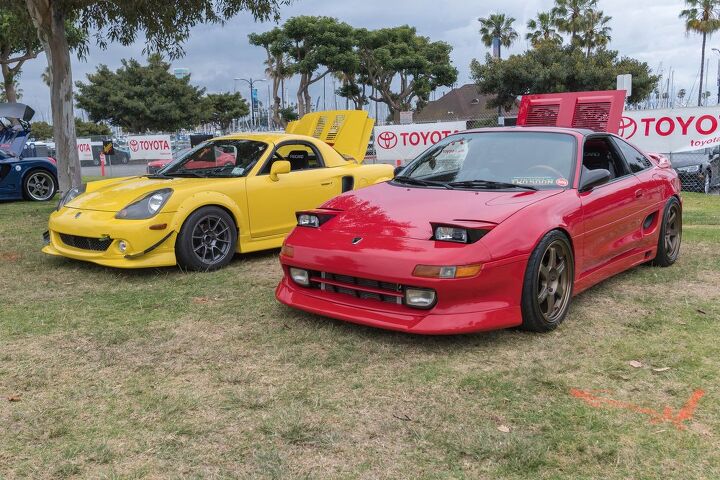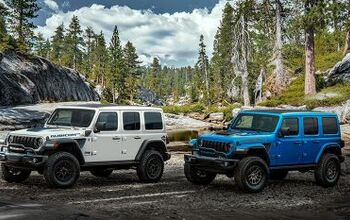Rumor: Toyota and Suzuki Developing Another Lightweight Sports Car

Toyota and Suzuki are rumored to be collaborating on another lightweight, mid-engine sports car with some help from Daihatsu. While nothing has been confirmed, the model is presumed to be a successor to Toyota’s MR2 (pictured) – as the automaker has offered numerous hints in the past that the little two-seater (or something inspired by it) would eventually enter into production.
Following the joint development of the Subaru BRZ and Toyota GR86, the latter brand suggested it would eventually offer a trio of sporting options that paid homage to some of its most iconic performance models. It was suggested that one would probably slot in beneath the Toyobaru twins. Considering we already have the Supra and 86 on sale, the MR2 feels like the obvious choice.
A report by Motor1 has cited numerous Japanese outlets claiming the three companies were actively developing a two-seater equipped with a centrally mounted 1.0-liter three-cylinder motor producing somewhere around 120 horsepower. Best Car magazine has said the car is basically being designed with Toyota in mind.
From Motor1:
The Japanese magazine claims the three domestic automakers are working on an affordable mid-engined Toyota sports car with a turbocharged 1.0-liter engine. The three-pot is said to produce nearly 120 horsepower and 200 Newton-meters (147 pound-feet) of torque. It is believed the ICE will have a mild-hybrid setup to provide a small boost and improve fuel economy.
While the rumored output is not exactly impressive, the "Midship Sports" mentioned by Best Car is said to weigh just 1,000 kilograms (2,204 pounds). That would make it just about as light as the base Mazda MX-5 with the 1.5-liter engine, which has 129 hp and 150 Nm (111 lb-ft). It's said to be significantly bigger than the Miata and the third-generation MR2 by measuring 4,200 millimeters (165.3 inches) long, 1,720 mm (67.7 in) wide, and 1,220 mm (48 in) tall, with a wheelbase of 2,550 mm (100 in).
Suzuki is reportedly developing the engine while the front suspension will be adapted from the current-generation Yaris. The styling is said to take cues from the Daihatsu Copen although the rendering published by Best Car shows a sleeker sports car that takes itself more seriously. It would be strictly a two-seat affair and carry the Toyota badge.
While your gut is correctly telling you that’s probably not going to fly in North America without the mystery model seeing a bump in power, keep in mind that the base MX-5 produces significantly more oomph on our shores than it does in Japan. It’s not inconceivable that Subaru could spice up the powertrain when-and-if Toyota ships the model our way. However, it’ll probably cost a bit more than what’s being suggested right now.
Motor1 stated that the new model would cost between 2.2 to 2.8 million yen on the Japanese domestic market, depending on trim level and options. That’s just $16,500 to $21,000 when converted to U.S. dollars. But it also warned that these are just rumors and rumors often don’t make it into the world of facts. As things currently stand, we don’t even know how far down the path of development the hypothetical MR2 happens to be or if it has any real chance of making it to the finish line.
[Image: betto rodrigues/Shutterstock]
Become a TTAC insider. Get the latest news, features, TTAC takes, and everything else that gets to the truth about cars first by subscribing to our newsletter.

A staunch consumer advocate tracking industry trends and regulation. Before joining TTAC, Matt spent a decade working for marketing and research firms based in NYC. Clients included several of the world’s largest automakers, global tire brands, and aftermarket part suppliers. Dissatisfied with the corporate world and resentful of having to wear suits everyday, he pivoted to writing about cars. Since then, that man has become an ardent supporter of the right-to-repair movement, been interviewed on the auto industry by national radio broadcasts, driven more rental cars than anyone ever should, participated in amateur rallying events, and received the requisite minimum training as sanctioned by the SCCA. Handy with a wrench, Matt grew up surrounded by Detroit auto workers and managed to get a pizza delivery job before he was legally eligible. He later found himself driving box trucks through Manhattan, guaranteeing future sympathy for actual truckers. He continues to conduct research pertaining to the automotive sector as an independent contractor and has since moved back to his native Michigan, closer to where the cars are born. A contrarian, Matt claims to prefer understeer — stating that front and all-wheel drive vehicles cater best to his driving style.
More by Matt Posky
Latest Car Reviews
Read moreLatest Product Reviews
Read moreRecent Comments
- Jalop1991 In a manner similar to PHEV being the correct answer, I declare RPVs to be the correct answer here.We're doing it with certain aircraft; why not with cars on the ground, using hardware and tools like Telsa's "FSD" or GM's "SuperCruise" as the base?Take the local Uber driver out of the car, and put him in a professional centralized environment from where he drives me around. The system and the individual car can have awareness as well as gates, but he's responsible for the driving.Put the tech into my car, and let me buy it as needed. I need someone else to drive me home; hit the button and voila, I've hired a driver for the moment. I don't want to drive 11 hours to my vacation spot; hire the remote pilot for that. When I get there, I have my car and he's still at his normal location, piloting cars for other people.The system would allow for driver rest period, like what's required for truckers, so I might end up with multiple people driving me to the coast. I don't care. And they don't have to be physically with me, therefore they can be way cheaper.Charge taxi-type per-mile rates. For long drives, offer per-trip rates. Offer subscriptions, including miles/hours. Whatever.(And for grins, dress the remote pilots all as Johnnie.)Start this out with big rigs. Take the trucker away from the long haul driving, and let him be there for emergencies and the short haul parts of the trip.And in a manner similar to PHEVs being discredited, I fully expect to be razzed for this brilliant idea (not unlike how Alan Kay wasn't recognized until many many years later for his Dynabook vision).
- B-BodyBuick84 Not afraid of AV's as I highly doubt they will ever be %100 viable for our roads. Stop-and-go downtown city or rush hour highway traffic? I can see that, but otherwise there's simply too many variables. Bad weather conditions, faded road lines or markings, reflective surfaces with glare, etc. There's also the issue of cultural norms. About a decade ago there was actually an online test called 'The Morality Machine' one could do online where you were in control of an AV and choose what action to take when a crash was inevitable. I think something like 2.5 million people across the world participated? For example, do you hit and most likely kill the elderly couple strolling across the crosswalk or crash the vehicle into a cement barrier and almost certainly cause the death of the vehicle occupants? What if it's a parent and child? In N. America 98% of people choose to hit the elderly couple and save themselves while in Asia, the exact opposite happened where 98% choose to hit the parent and child. Why? Cultural differences. Asia puts a lot of emphasis on respecting their elderly while N. America has a culture of 'save/ protect the children'. Are these AV's going to respect that culture? Is a VW Jetta or Buick Envision AV going to have different programming depending on whether it's sold in Canada or Taiwan? how's that going to effect legislation and legal battles when a crash inevitibly does happen? These are the true barriers to mass AV adoption, and in the 10 years since that test came out, there has been zero answers or progress on this matter. So no, I'm not afraid of AV's simply because with the exception of a few specific situations, most avenues are going to prove to be a dead-end for automakers.
- Mike Bradley Autonomous cars were developed in Silicon Valley. For new products there, the standard business plan is to put a barely-functioning product on the market right away and wait for the early-adopter customers to find the flaws. That's exactly what's happened. Detroit's plan is pretty much the opposite, but Detroit isn't developing this product. That's why dealers, for instance, haven't been trained in the cars.
- Dartman https://apnews.com/article/artificial-intelligence-fighter-jets-air-force-6a1100c96a73ca9b7f41cbd6a2753fdaAutonomous/Ai is here now. The question is implementation and acceptance.
- FreedMike If Dodge were smart - and I don't think they are - they'd spend their money refreshing and reworking the Durango (which I think is entering model year 3,221), versus going down the same "stuff 'em full of motor and give 'em cool new paint options" path. That's the approach they used with the Charger and Challenger, and both those models are dead. The Durango is still a strong product in a strong market; why not keep it fresher?


































Comments
Join the conversation
I have a 2004 and 1991 MR2. The 91 was a barn find with only 52k miles.
-darts eyes- imagine one one of these with a tune and tires that are the equivalent of gum erasers. Casual Friday and weekend car. My local coffee and cars is across the street from Wallyworld.